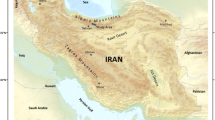Abstract
Gar and Bare Anticlines are located in the Zagros mountain range, southern Iran. The cores of the anticlines are comprised of the calcareous Sarvak formation sandwiched between two impermeable marly formations, namely Pabdeh-Gurpi at the top and Kazhdomi at the bottom. Sheshpeer spring with an average discharge rate of 3.2 m\(^{3}\) s\(^{-1}\) emerges from the Gar Anticline, forming the Sheshpeer River. To the west, the Sheshpeer River is delimited by the Albian aged calcareous Sarvak formation, while the Santonian-Oligocene impermeable deposits of the marly Pabdeh-Gurpi formation constitute the eastern limit. Sheshpeer Dam is currently under study and under construction. Parts of the Sheshpeer riverbed lie directly on the Sarvak formation and its water seeps into the adjacent karst aquifer at a rate of approximately 340–650 l s\(^{-1}\) which will increase undoubtedly after reservoir impoundment. In addition, two tracing tests, for determination of underground seepage flow path(s) were accomplished. However, no dye tracer was detected in any source of ground water located downstream of the reservoir. Interestingly, water levels of the studied boreholes have dropped during drilling operations indicating the existence of a deep karst aquifer in the region. Finally, the seepage flow direction was investigated and assumed to be most likely parallel to Gar Anticline which strikes toward the adjacent Bare Anticline based on the dye tracing, borehole permeability, water table profiles, water budget, hydrochemistry of water resources and due to the presence of extensive crushed zones on the southern flank of the Gar Anticline.
















Similar content being viewed by others
References
Ashjari J, Raeisi E (2006) Influences of anticlinal structure on regional flow Zagros, Iran. J Cave Karst Stud 68(3):118–129
Atkinson TC (1977) Diffuse flow and conduit flow in limestone terrain in the Mendip Hills, Somerset (Great Britain). J Hydrol 35(1):93–110
Bakalowicz M (2005) Karst groundwater: a challenge for new resources. Hydrogeol J 13(1):148–160
Bonacci O, Rubinić J (2009) Water losses from a reservoir built in karst: the example of the boljunica reservoir (Istria, Croatia). Environ Geol 58(2):339–345
Breznik M (1998) Storage reservoirs and deep wells in karst regions. A.A. Balkema, Rotterdam
Dreybrodt W, Romanov D, Gabrovsek F (2002) Karstification below dam sites: a model of increasing leakage from reservoirs. Environ Geol 42(5):518–524
Ford DC, Williams PW (2007) Karst hydrogeology and geomorphology. Wiley, Hoboken
Ghobadi M, Khanlari G, Djalaly H (2005) Seepage problems in the right abutment of the shahid abbaspour dam, southern Iran. Eng Geol 82(2):119–126
Heidari H (2009) Study of karst hydrology in the Sheshpir Dam [Master’s thesis]: Shiraz. University of Shiraz, Iran
James G, Wynd J (1965) Stratigraphic nomenclature of iranian oil consortium agreement area. AAPG Bull 49(12):2182–2245
Karimi H, Raeisi E, Zare M (2005) Physicochemical time series of karst springs as a tool to differentiate the source of spring water. Carbonates Evaporites 20(2):138–147
Kresic N, Stevanovic Z (2009) Groundwater hydrology of springs: Engineering, theory, management and sustainability. Butterworth-Heinemann, Oxford
McWhorter DB, Sunada DK (1977) Ground-water hydrology and hydraulics. Water Resources Publication, Littleton
Milanovic P (2002) The environmental impacts of human activities and engineering constructions in karst regions. Episodes 25(1):13–21
Milanović P (2014) Hydraulic properties of karst groundwater and its impacts on large structures, in H2karst research in limestone hydrogeology. Springer, New York, pp 19–48
Milanovic S, Stevanovic Z, Jemcov I (2010) Water losses risk assessment: an example from carpathian karst. Environ Earth Sci 60(4):817–827
Mohammadi Z, Raeisi E, Bakalowicz M (2007) Method of leakage study at the karst dam site. A case study: Khersan 3 Dam, Iran. Environ Geol 52(6):1053–1065
Palmer NA (2010) Understanding the hydrology of karst. Geologia Croatica 63(2):143–143
Parise M, De Waele J, Gutierrez F (2008) Engineering and environmental problems in karstan introduction. Eng Geol 99(3):91–94
Pezeshkpour P (1991) Hydrogeological and hydrochemical evaluation of kuhe gar-barm-firooz springs [Master’s thesis]: Shiraz. University of Shiraz, Iran, p 282
Poormorad A (2011) Study of groundwater direction and karst development in th right embankment of sheshpeer dam using rhodamine dye tracer [Master’s thesis]: Shiraz. University of Shiraz, Iran
Raeisi E, Karami G (1996) The governing factors of the physicochemical characteristics of Sheshpeer karst springs, Iran. Carbonates and Evaporites 11(2):162
Raeisi E, Karami G (1997) Hydrochemographs of Berghan karst spring as indicators of aquifer characteristics. J Cave Karst Stud 59(3):112–118
Raeisi E, Zare M, Eftekhari P (1999) Application of dye tracing for determining characteristics of sheshpeer karst spring, Iran. Theor Appl Karstol 11(12):109–118
Rezaei A, Karimi H, Zhan H (2017) The importance of understanding the hydrogeology and geochemistry of karst terrains for safely siting dams. J Cave Karst Stud 79(1):48
Romanov D, Gabrovsek F, Dreybrodt W (2003) Dam sites in soluble rocks: a model of increasing leakage by dissolutional widening of fractures beneath a dam. Eng Geol 70(12):17–35
Romanov D, Gabrovsek F, Dreybrodt W (2007) Leakage below dam sites in limestone terrains by enhanced karstification: a modeling approach. Environ Geol 51(5):775–779
Shuster ET, White WB (1971) Seasonal fluctuations in the chemistry of lime-stone springs: a possible means for characterizing carbonate aquifers. J Hydrol 14(2):93–128
Stöcklin J (1971) Stratigraphic lexicon of Iran. No. 18. Geological Survey of Iran
Turkmen S, Özgüler E, Taga H, Karaogullarindan T (2002) Seepage problems in the karstic limestone foundation of the kalecik dam (south turkey). Eng Geol 63(3):247–257
White WB (1988) Geomorphology and hydrology of karst terrains. Oxford University Press, New York
Acknowledgements
Financial support for this study was provided by the Shiraz University council. We would like to take this opportunity to thank the Shiraz University for offering this subject and computing project.
Author information
Authors and Affiliations
Corresponding author
Rights and permissions
About this article
Cite this article
Mehr, S.S., Raeisi, E. Investigation of seepage flow path(s) in the right embankment of Sheshpeer Dam, the Zagros Region, Iran. Carbonates Evaporites 34, 1321–1331 (2019). https://doi.org/10.1007/s13146-018-0426-1
Accepted:
Published:
Issue Date:
DOI: https://doi.org/10.1007/s13146-018-0426-1




